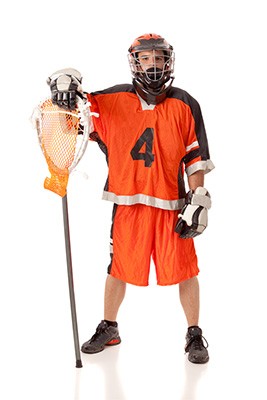When it comes to the sport of lacrosse, many lacrosse players aspire to make it to the college level or even beyond.
But how much does height really matter when playing this sport? Does a player's stature give them an advantage, or can shorter players reach their goals too?
This blog post will look at some factors that impact lacrosse ability and assess does height matter in lacrosse when considering success in the game.
More...
Take Away Key Points:
Is height important in lacrosse?

When it comes to lacrosse, many people think that height is the determining factor in success. But the truth is that while the height can be beneficial, it's far from the only aspect of the game that matters.
While tall players may have an edge in certain areas, they need to be just as well-rounded athletes as their shorter counterparts if they genuinely want to excel in lacrosse.
Height helps players wield long sticks more effectively, reach and control long passes more efficiently, and keep goalies out of shooting lanes and off potential rebounds. But there's much more involved in the game than just being able to reach a pass or block a shot: a player needs strength, agility, stamina, and hand-eye coordination, all of which can help make up for lack of size.
Therefore, players need to strengthen their other skills to compensate for any perceived lack of reach or size instead of focusing solely on size when playing lacrosse.
With practice and dedication, anyone can become an excellent lacrosse player—regardless of height!
Do taller players have more advantages to play lacrosse?
Regarding lacrosse, height and size play a great role for taller players as they have some advantages over shorter players. They can potentially reach higher and longer passes, wield their lacrosse stick skills, better hand speed, and better defend the goal by blocking shots and taking up space in shooting lanes.
However, it's important to note that these advantages don't necessarily make a player automatically better than a shorter one. Just because one is tall doesn't mean one will automatically be successful.
It's just as crucial for taller players to train and practice other aspects of their game, such as strength and agility, hand-eye coordination, and stamina, to become excellent lacrosse players.
Though height size matter as it can give certain advantages in lacrosse playing style and technique, ultimately, it's the individual's hard work and dedication to honing the skills that will lead them to success in the game—regardless of size!
Benefits of being a tall player in lacrosse
Being tall in lacrosse can provide several advantages. Some of the benefits include:
Can short players succeed in lacrosse?
Although height size matter can be an advantage for some players, it is not a prerequisite for success in lacrosse.
Developing good technique and tactical decision-making are essential skills for players to have, regardless of their size. They must also understand positioning on the field, make quick decisions, and accurately pass and shoot.
With these attributes combined with an individual's speed, any player can become skilled regardless of size or height.
Benefits of being a short player in lacrosse
Being short in lacrosse can provide several advantages. Some of the benefits include:
How does the height of the player affect playing positions?

When it comes to lacrosse, a player's height can affect their playing position.
Additionally, there is a certain balance that needs to be achieved amongst all the players on a team for them to succeed. For example, a good mix of tall and short players can create advantages on both sides of the offense/defense equation, allowing shorter attackers to duck under long passes. In contrast, taller defenders attempt to block shots or intercept passes.
Here's a look at which roles require various heights and whether they really matter at all.
1. Defense
Tall players are typically better suited to play defense in lacrosse, as they have the reach to be able to challenge shots and passes more effectively.
Generally speaking, taller lacrosse players are better suited for close defensemen roles as they have longer sticks that can reach higher and block shots or intercept passes more easily. They also can take up more space in shooting lanes on the defensive side when guarding against advances from the opponent team.
The long stick of a taller player can also help them maintain possession of the ball and keep their opponents from gaining ground, using these extended arms to effectively hold off an opponent and ward off any attempts to steal the ball.
However, having a tall stature does not necessarily guarantee success in a close defenseman position. It's just as crucial for these players to practice their agility and hand-eye coordination to become successful defenders.
Overall, height can be an advantage for defensive positions in lacrosse—but each player needs to hone their skillset to make the most of this advantage.
2. Midfield/Attack
Midfielders are usually smaller than those playing defense, but they still need to cover the ground quickly and possess good ball-handling skills. If you're looking to play this position, having a slightly above-average height can help with your ability to distribute the ball as an offensive player.
However, a taller stature is not the only factor that affects success at the midfield position and the offensive end. Agility, speed, and hand-eye coordination are all important skills that midfielders must possess to succeed.
In addition, shorter players may use their smaller size as an advantage by being quicker and more maneuverable than their larger opponents.
3. Goalie
Height is one of the most critical factors for goalies in lacrosse. Generally speaking, taller players are better suited for this role because of their longer sticks which enable them to reach higher and block shots or intercept passes more easily.
They also can take up more space in shooting lanes when guarding against advances from the other team.
A tall goaltender can also help maintain possession of the ball and keep opponents from gaining ground by using their long sticks to effectively hold off an opponent or ward off any attempts to steal the ball.
How tall is an average lacrosse player?
The average height of a lacrosse player is generally between 5'9" and 6'2". However, there are players of all sizes, from tall, lanky attackers to short but speedy midfielders.
Height can give a player an advantage in certain positions. For example, taller players are often better-suited for defensive or goaltending roles as they tend to have longer sticks that give them greater reach, along with a larger wingspan which helps them defend against advances from the other team.
Shorter players may use their smaller size as an advantage by being quicker and more maneuverable than their larger opponents.
Does height matter in women's lacrosse?
Height is undoubtedly a factor to consider when playing women's lacrosse. Although the average size and height of a women's lacrosse player can vary, taller players tend to have an advantage in terms of reach and ability to cover more ground on defense. They may also be better at blocking shots or intercepting passes due to their larger wingspan.
However, height isn't everything in women's lacrosse – speed, agility, and hand-eye coordination are all essential factors that impact how well a player performs on the field.
Shorter players can still make excellent defenders or attackers – their smaller size allows them greater maneuverability and agility that tall players may lack.
How does body type affect lacrosse gameplay?
Body type and physical stature can directly impact how players perform on the field in men's lacrosse. In addition, different body types can provide various advantages and disadvantages depending on the position and style of play.
Players with larger, thicker body type builds may be able to withstand better physical contact from opponents and use their strength advantageously.
This could allow them to take more risks by putting themselves into positions where they can generate power for shots or passes.
On the flip side, more slender body type players may not have the same strength and power but could possess more agility and maneuverability that allows them to evade defenders. Of course, the ideal body type depends heavily on the player's desired role on the team, along with other factors such as skill level and experience.
While some body types may be better suited for certain roles, men's lacrosse is ultimately a game of versatility. Therefore, all athletes should strive to develop skills and strategies that help them succeed regardless of size or build.
Do college lacrosse coaches look for height & weight in recruits?
Height and weight play a significant role in sports!
College coaches look for various factors when evaluating potential recruits for college lacrosse, and height and weight can certainly be a factor.
Generally, coaches will want tall players to provide an advantage in their respective positions on the field.
For example, most lacrosse players and taller midfielders might have better reach and accuracy with strikes on goals for college lacrosse. Likewise, shorter midfielders may have better agility when evading defenders.
Additionally, college lacrosse coaches may also assess whether a player is at an appropriate weight to perform in their position effectively. For example, being too heavy can slow down a player's speed, while being too light could lead to difficulty with defensive plays.
Ultimately, college lacrosse coaches will evaluate recruits based on traits such as athleticism, size, skill level, and stick skills to determine if they are the right fit for the team.
Does height matter for NCAA Division I lacrosse?

Division I men's lacrosse is a highly competitive sport, and many teams look for players with certain physical attributes. While height may be a factor that coaches consider when recruiting players, it is not the only one.
Taller players may have an advantage in certain aspects of the game, such as reaching higher ground balls or out-run opponents. However, being taller can also present challenges regarding agility and mobility on the field.
Additionally, Division I teams are looking for athletes who can use their physical attributes effectively and demonstrate proficiency with defensive skills and offensive plays.
Ultimately, the importance of height varies from team to team and coach to coach. Therefore, it is possible that taller players could gain an advantage in some instances while shorter players could do so in others.
Therefore, Division I coaches consider multiple factors, but height does matter at the lacrosse DI level.
FAQs
How important is height in lacrosse?
Height can be an advantage in lacrosse, but it isn't the only factor determining success. Players of all sizes can excel in lacrosse, and a good mix of tall and short players creates advantages for both offensive and defensive play.
Can you be short and play lacrosse?
Absolutely! Players of all sizes can succeed in lacrosse, and a good mix of tall and short players creates advantages for both offensive and defensive play.
Shorter players may use their smaller size as an advantage by being quicker and more maneuverable than their larger opponents. When playing defense, shorter players can often duck underpasses or avoid getting blocked by taller attackers and have better stick skills.
How tall are lacrosse goals?
Lacrosse goals are 6 feet tall and 6 feet wide. The dimensions of the goal must remain consistent, with the crossbar being exactly 6 feet off the ground, and the posts can be up to a maximum of 12 inches deep. Additionally, all welding and thickening of the goal frame must be completed away from any area used by players or referees.
Do you have to be fast to be good at lacrosse?
Lacrosse is considered the fastest sport on two feet, but no, speed is not the only factor in being a good lacrosse player. While a player's agility and quickness can give them an advantage on the field, it is not necessary for success in the game.
Other important skills for succeeding at lacrosse include positioning, speed, anticipating plays, reading opponents, accurate passing and shooting, and decision-making ability.
Is height related to increasing Lacrosse IQ?
Height is not necessarily a major factor in increasing lacrosse IQ. Generally, taller players can have a longer reach and more physical presence on the field. However, there are plenty of smaller players who possess great lacrosse intelligence, awareness, and skillset.
For players to increase their lacrosse IQ and succeed at the sport, they must focus on technique and tactical decision-making, just like in other sports.
Conclusion
In conclusion of does height matter in lacrosse: height is not necessarily a major factor for success in this popular contact sport.
Players of any size can succeed on the field if they focus on developing good technique and tactical decision-making.
This includes accurate passing and shooting, adequate skill sets, reading opponents, understanding positioning on the field, and making quick decisions.
